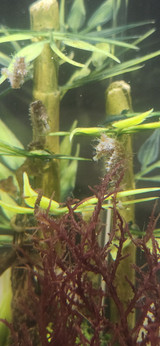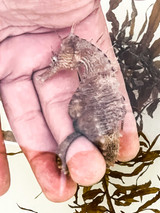Introduction to our special Captive bread Dwarf seahorses.
Tank raised seahorses can be more adaptive than wild caught dwarf seahorses to being transplanted from our culture aquariums to your home display aquarium.
Our captive raised dwarf seahorses will readily eat all types of live food that you can find in our inventory under category live foods.
It takes a lot of time for an aquarist hobbyist to dedicate themselves to feeding a seahorse tank as seahorses need to constantly eat through out the daylight cycle and can be very slow eaters.
Dwarf seahorses have a very small stomach that cannot hold extra food for extended no eating hours.
Best live feeds for our tank raised seahorses are live amphipods, Copepods, and newly hatched artemia nauplii, also known as live baby brine shrimp.
Best and most efficient way to keep a seahorse tank is to provide a variety of live prey organisms and then just try to monitor the small live food items in the seahorses aquarium.
We call this feeding the tank or aquarium instead of focusing directly on feeding the seahorse or fish that we keep.
The best and most interesting points about using our method to maintain a healthy live dwarf seahorse aquarium is that the live zooplankton will pollute the water quality a lot less than traditional feeding.
Live amphipods and copepods can and will reproduce in the system thus providing longer intervals between feeding times. So the aquarist doesn't have to constantly feed the aquarium on a daily basis or even multiple times per day.
Best place to buy dwarf seahorses is a full scale marine fish nursery like Rusalty that has all the live food cultures readily available to ship to your door when you and your pet seahorses need it.
When a dwarf seahorse is healthy and contained in a healthy captive environment they can grow protrusions called (cirri) or little spikes all over the body to simulate algae or seaweed like you see in the pictures with some of our specimens.
Some dwarfs will exhibit this growth more than others but it also depends greatly on the nutrition that they are receiving and the environment that we keep them in with natural saltwater plants or macro algae.
This greatly extends the survivability of the dwarf seahorse by allowing it to camouflage to it's habitat.
Cirri growths give our dwarf seahorses a striking more exotic appearance that is rare to find in the aquarium hobby.
- ship_option_category:
- A








